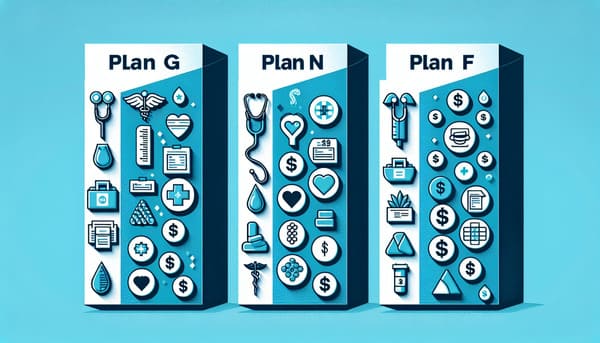
by Russell Noga | Updated March 8th, 2024
As 2025 approaches, are you wondering which Medicare Supplement plans in Washington State are right for you? This article cuts through the complexity, providing you with a concise overview of the Medicare Supplement Plans Washington State 2025, also known as Medigap plans, available, recent policy changes, and how these impact your healthcare options. Tailor your health insurance decisions to your needs and finances with our straightforward guide.
Key Takeaways
- Medicare Supplement (Medigap) plans in Washington State provide essential coverage for costs not covered by Original Medicare but cannot be combined with Medicare Advantage plans.
- Recent legislative changes, including a $2,000 cap on Part D out-of-pocket spending and direct Medicare negotiations for certain drugs, are aimed at making healthcare and prescription drugs more affordable.
- Enrollment in Medicare Supplement is optimal during the six-month period beginning when you turn 65 and are enrolled in Medicare Part B, with additional Special Enrollment Periods available for specific life events.
Compare 2025 Plans & Rates
Enter Zip Code
Understanding Medicare Supplement Plans in Washington State 2025

Medicare Supplement plans, also known as Medigap, offer a lifeline to many residents in Washington State. These plans come in handy by filling the gaps left by Original Medicare, including copayments, coinsurance, and deductibles. With a Medicare Supplement plan, you can enjoy peace of mind knowing that unexpected healthcare costs won’t wreak havoc on your finances. Medicare supplement insurance is an essential tool for ensuring comprehensive coverage.
Bear in mind that you can’t combine Medicare Advantage plans with a Medicare Supplement plan. These two are mutually exclusive, thus making it critical to understand each plan’s benefits and potential drawbacks. This understanding will enable you to make an informed decision that aligns with your healthcare needs and financial capabilities.
Recent Changes and Updates
Keeping up with the recent changes and updates impacting Medicare Supplement plans is of utmost importance. One significant update that stands out is the expansion of the Extra Help program starting in 2024. With this expansion, generic drugs will be capped at $4.50 and brand-name drugs at $11.20. Furthermore, the Part D out-of-pocket spending limit will be capped at $2,000 starting in 2025.
There’s more! Starting in 2026, Medicare will negotiate directly with manufacturers for certain high-cost brand-name Part B and Part D drugs, lacking competition, aiming to lower prescription drug costs. Moreover, a new prescription drug law that took effect on January 1, 2023, has improved access to affordable treatments, including more vaccines at no cost for Part D beneficiaries and reduced coinsurance for Part B drugs, with prices outpacing inflation. These changes are a testament to the government’s commitment to making healthcare more affordable.
Eligibility Requirements
Having examined the current changes and updates, now let’s move on to the eligibility criteria for Medicare Supplement plans. In Washington State, individuals have guaranteed issue rights during the Initial Enrollment Period. However, individuals under 65 may face some hurdles due to age restrictions.
On a brighter note, disabled Medicare beneficiaries in Washington who turn 65 gain access to the Medigap Open Enrollment Period. This period allows them to select from any available Medigap plan at a standard community-rated premium without discrimination due to their earlier disability. This provision ensures that all beneficiaries have equal access to the healthcare services they need, including those offered by Medicare Advantage insurers.
Comparing Popular Medicare Supplement Plans

Armed with knowledge of recent changes and eligibility criteria, let’s examine the popular Medicare Supplement Plans. Three plans stand out due to their popularity and benefits: Plan G, Plan N, and High-Deductible Plan F. Each of these plans offers unique benefits, which we will explore in the ensuing subsections.
Keep in mind that personal factors can affect the cost of Medicare Supplement plan premiums in Washington State. These factors include:
- Your age
- Your gender
- Your smoking status
- Your health history
Understanding this aspect is key to planning your finances and selecting a plan that aligns with your financial capabilities.
Plan G
Let’s kickstart our comparison with Plan G. This plan is renowned for its comprehensive coverage, including the Medicare Part A deductible, Part B excess charges, and foreign travel emergency care. With Plan G, you can rest easy knowing that you’re sufficiently covered for most healthcare expenses.
Plan G offers the following benefits:
- A copayment of up to $20 for some office visits
- Coverage for the first three pints of blood for a medical procedure
- Skilled nursing facility care coinsurance
- 80% coverage for foreign travel emergency care up to the plan’s limits
With Plan G, you can access any Medicare-contracted physician or hospital nationwide, providing you with the flexibility to choose from a wide network of providers.
Plan N
Next on our comparison list is Plan N. This plan covers the Medicare Part A deductible, coinsurance, and hospital costs up to an additional 365 days after Medicare benefits are exhausted. Plan N generally has lower premiums than Plan G, making it an attractive choice for those on a budget. However, it’s essential to note that Plan N requires a copayment for doctor visits and emergency room visits that do not result in an inpatient admission.
On the other hand, Plan N does not cover the Medicare Part B excess charges. This aspect means that you’ll have to pay out-of-pocket for these charges, which can impact your overall healthcare costs. Understanding these nuances is key to selecting a plan that meets your healthcare needs and financial circumstances.
High-Deductible Plan F
Lastly, we have the High-Deductible Plan F. This plan offers the same comprehensive coverage as the standard Plan F, including Medicare Part A and Part B deductibles, coinsurance, and copays. However, beneficiaries must first meet a higher out-of-pocket deductible before they can enjoy the benefits of this plan’s coverage.
Despite its comprehensive coverage, High-Deductible Plan F does not cover services such as vision, hearing exams, or routine physical exams. Moreover, there is no prescription drug coverage included, necessitating enrollees to secure a separate plan for prescription drugs.
Understanding these limitations and proposed rules will help you make an informed decision and plan your healthcare expenses accordingly.
Compare Medicare Plans & Rates in Your Area
Prescription Drug Coverage and Medicare Supplement Plans

As we explore prescription drug coverage, it’s worth noting that Medicare Supplement plans in Washington State usually don’t include it. As such, Washington residents with Medicare Supplements need to enroll in a stand-alone Part D plan for prescription drug coverage. Choosing the right Medicare Supplement plan requires evaluating individual prescription drug needs and coverage options.
To help you in this process, you can leverage resources such as Washington’s State Health Insurance Assistance Program (SHIP) and Medicare resources provided by the federal government. These resources offer valuable information on prescription drug coverage options, helping you make an informed decision.
Stand-Alone Part D Plans
Stand-alone Part D plans are instrumental in providing prescription drug coverage for beneficiaries enrolled in Original Medicare. These plans can be combined with a Medicare Supplement plan, providing a comprehensive healthcare coverage package. In Washington State, beneficiaries have various Part D plan options, each with:
- a different formulary
- premiums
- deductibles
- cost-sharing structures
A comparison of Part D plans in Washington State is crucial due to the varying coverage of prescription drugs and the differences in costs between plans. For example, the Inflation Reduction Act has instituted a cap on annual out-of-pocket Part D costs at $2,000, set to commence in 2025. Moreover, Part D beneficiaries now pay no more than $35 for a one-month supply of covered insulin, with the Part B deductible waived for insulin via a pump. These changes impact the overall cost of healthcare, making it crucial to understand them.
Lowering Prescription Drug Costs
CMS has announced detailed improvements to the Medicare Part D drug benefit for 2025, designed to decrease prescription drug costs for individuals with Medicare. A significant change for Medicare Part D resulting from the Inflation Reduction Act is the implementation of a $2,000 cap on annual out-of-pocket drug costs, which will take effect in 2025. This change is a testament to the government’s commitment to making healthcare more affordable for all Americans, following the proposed rules released.
The $2,000 cap on annual out-of-pocket drug costs is a significant relief for many beneficiaries, as it lowers their healthcare expenses. With this change in place, beneficiaries can enjoy better healthcare services without worrying about exorbitant out-of-pocket costs. This development underscores the importance of staying abreast with changes in healthcare legislation and understanding their impact on healthcare costs.
Enrollment Process and Timeline

It’s vital to grasp the enrollment process and timeline for Medicare Supplement plans in Washington State to secure these benefits. To enroll in a Medigap plan, you must first be enrolled in Original Medicare Parts A and B. The best time to enroll in a Medigap plan is during the six-month period beginning when you turn 65 and are enrolled in Medicare Part B.
Enrollment in a Medigap plan is done by contacting the insurance company directly. For detailed questions regarding health screenings or switching Medigap plans, the Insurance Consumer Hotline in Washington State can provide assistance. This resource is helpful for navigating the enrollment process and ensuring you secure the right plan for your healthcare needs.
Open Enrollment Period
The Open Enrollment Period is a significant window for Medicare Supplement plans. Washington State residents have a one-time six-month open enrollment period for Medigap. This period is crucial as it allows individuals to enroll in Medicare Supplement plans without medical underwriting.
Unlike enrollment periods for other types of health insurance, this period occurs only once and not annually. For an individual enrollee in Washington State, the six-month period begins when they first sign up for Medicare benefits. Understanding this period is key to securing your healthcare benefits in a timely manner.
Special Enrollment Periods
Special Enrolment Periods (SEPs) are vital for individuals needing to modify their plans outside the Open Enrollment Period. In Washington State, Medigap enrollees can switch to a different Medigap plan any time, guaranteed-issue, which surpasses the one-time six-month open enrollment period defined by federal rules.
SEPs in Washington State may be granted due to life events such as moving to a new area not covered by your current plan or losing other health insurance coverage. Understanding these periods and the types of plan changes allowed during a SEP is key to maintaining your healthcare coverage in the face of life’s uncertainties.
Finding Providers and Hospitals

Locating providers and hospitals that accept your Medicare Supplement plan is key to accessing healthcare services, including Medicaid services. Beneficiaries looking for Medicare Supplement plan providers in Washington State can use Premera Blue Cross’s online provider directory to find eligible healthcare providers.
In Washington State, Medicare Supplement Plan G is administered by Premera Blue Cross, one of the medicare advantage insurers code compliant companies. This plan allows beneficiaries to use any Medicare-contracted physician or hospital nationwide. This flexibility ensures that beneficiaries can access healthcare services no matter where they are in the country.
Provider Directories
Provider directories are invaluable resources for Medicare Supplement plan beneficiaries to locate relevant healthcare providers. Beneficiaries can utilize online provider directories to locate doctors and hospitals in Washington State that are part of their Medicare Supplement network.
The online provider directory is a key resource for enrollees of Medicare Supplement Plan G in Washington State to locate healthcare providers. In case available provider directories do not provide sufficient information, beneficiaries may contact the insurance company for assistance.
Nationwide Coverage
Medicare Supplement plans in Washington State generally provide nationwide coverage, allowing policyholders to receive care from any provider in the U.S. that accepts Medicare. This aspect provides greater flexibility when traveling or seeking specialized medical care outside your home state.
Some Medicare Supplement plans include supplemental benefits for emergency medical care when traveling outside the U.S., known as foreign travel emergency care. However, bear in mind that Medigap plans typically don’t cover items such as long-term care, vision or dental care, hearing aids, eyeglasses, or private-duty nursing. Understanding these limitations will help you plan your healthcare expenses and avoid unexpected costs.
Financial Considerations
Grasping the financial considerations for Medicare Supplement plan beneficiaries is of utmost importance. Medicare Supplement plan premiums in Washington State can vary.
Medicare Supplement plans in Washington State have varying deductibles, with Plan G and N having a standard annual deductible, while High-Deductible Plan F has a higher deductible before full coverage begins. Out-of-pocket costs, including copayments and coinsurance, differ per plan, with Plan N generally having higher copayments for office and emergency room visits.
Premiums
In Washington state, Medicare Supplement premiums for enrollees age 65 and older are based on a community rating system, which means premiums are not based on age. This aspect can help you plan your healthcare expenses and ensure that you secure a plan that aligns with your financial capabilities.
Premiums for Medicare Supplement plans in Washington State can be reduced through various discounts offered by insurers, such as household or marital discounts. These discounts can significantly lower your healthcare costs, providing you with the financial flexibility to access the healthcare services you need.
Deductibles and Out-of-Pocket Costs
Medicare Supplement plans may cover deductibles and copayments, which are out-of-pocket costs not covered by original Medicare. For Plan N, the Medicare Part A deductible, coinsurance, and hospital costs after Medicare benefits are exhausted are covered.
However, Plan N imposes a copayment of up to $20 for some office visits and up to $50 for emergency room visits, which does not result in inpatient admission. These costs can impact your overall healthcare expenses and should be considered when selecting a Medicare Supplement plan.
Summary
Navigating the intricacies of Medicare Supplement Plans in Washington State for 2025 is no small feat. However, with this comprehensive guide, you’re now better equipped to understand the recent changes and updates, compare popular Medicare Supplement Plans, explore prescription drug coverage options, understand the enrollment process, and find providers and hospitals that accept your plan.
Armed with this knowledge, you’re on your way to securing a Medicare Supplement plan that meets your healthcare needs and aligns with your financial capabilities. Remember, your health is your wealth. Choose wisely, and live healthily!
Compare 2025 Plans & Rates
Enter Zip Code
Frequently Asked Questions
What is the Medicare Advantage rate notice for 2025?
The Medicare Advantage rate notice for 2025 has not been released yet. Please check the official Medicare website for updates.
Are Medicare Supplement plans being phased out?
Yes, Medicare Supplement Plan F is being phased out starting January 1, 2020, but if you currently have this plan, you can keep it as long as you want. Those becoming eligible for Medicare after January 1, 2020, won’t be able to purchase Plan F.
What is the US proposed reimbursement rate for Medicare Advantage 2025 payments?
The US proposed reimbursement rate for Medicare Advantage 2025 payments is 3.7%. This information was included in a recent CMA Alert, and CMS released an Advance Rate Notice for 2025 (source: CMS fact sheet).
What are the recent changes to Medicare Supplement Plans in Washington State for 2025?
In 2025, the recent changes to Medicare Supplement Plans in Washington State include the expansion of the Extra Help program, capping annual out-of-pocket Part D costs, and direct negotiation by Medicare with manufacturers for certain high-cost brand-name Part B and Part D drugs.
Speak to the Professionals about Medigap Plans and Original Medicare
If you find understanding the benefits involved with Original Medicare and Medigap Plans challenging, you’re not alone. Whether it’s a Medigap plan, or you want to know more about Medicare Supplement Plans Washington State, we can help. Call our team at 1-888-891-0229 for a free consultation or complete the contact form on this site, and an expert will call you back at a convenient time.
We have decades of experience advising our clients on the complexities of Medicare and Medigap plans, the benefits, cost and deductibles. We’ll ensure you get the best rate in your state and advice you can trust.



